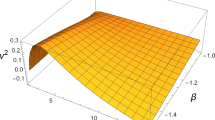Abstract
We construct explicit examples of globally regular static, spherically symmetric solutions in general relativity with scalar and electromagnetic fields describing traversable wormholes with flat and AdS asymptotics and regular black holes, in particular, black universes. (A black universe is a regular black hole with an expanding, asymptotically isotropic space-time beyond the horizon.) The existence of such objects requires invoking scalars with negative kinetic energy (“phantoms, ” or “ghosts”), which are not observed under usual physical conditions. To account for that, the so-called “trapped ghosts” were previously introduced, i.e., scalars whose kinetic energy is only negative in a restricted strong-field region of space-time and positive outside it. This approach leads to certain problems, including instability (as is illustrated here by derivation of an effective potential for spherical pertubations of such systems). In this paper, we use for model construction what we call “invisible ghosts, ” i.e., phantom scalar fields sufficiently rapidly decaying in the weak-field region. The resulting configurations contain different numbers of Killing horizons, from zero to four.
Similar content being viewed by others
References
P. A. R. Ade et al. (Planck Collaboration), “Planck 2015 results. XIII. Cosmological parameters,” ArXiv: 1502.01589.
M. Visser, Lorentzian Wormholes: from Einstein to Hawking (AIP, Woodbury, 1995).
K. A. Bronnikov and S. G. Rubin, Black Holes, Cosmology and Extra Dimansions (World Scientific, Singapore, 2012).
Francisco S. N. Lobo, “Time machines and traversable wormholes in modified theories of gravity,” EPJ Web Conf. 58, 01006 (2013); ArXiv: 1212.1006.
K. A. Bronnikov and M. V. Skvortsova, “Cylindrically and axially symmetric wormholes. Throats in vacuum?,” Grav. Cosmol. 20, 171 (2014); ArXiv:1404.5750.
D. Hochberg and M. Visser, Phys. Rev. D 56, 4745 (1997); gr-qc/9704082.
K. A. Bronnikov and J. C. Fabris, “Regular phantom black holes,” Phys. Rev. Lett. 96, 251101 (2006); grqc/0511109.
K. A. Bronnikov, V. N. Melnikov, and H. Dehnen, “Regular black holes and black universes,” Gen. Rel. Grav. 39, 973 (2007); gr-qc/0611022.
K. A. Bronnikov and S. V. Sushkov, “Trapped ghosts: a new class of wormholes,” Class. Quantum Grav. 27, 095022 (2010); ArXiv: 1001.3511.
K. A. Bronnikov and E. V. Donskoy, “Black universes with trapped ghosts,” Grav. Cosmol. 17, 176 (2011); ArXiv: 1110.6030.
K. A. Bronnikov, E. V. Donskoy, and P. A. Korolev, “Magnetic wormholes and black universes with trapped ghosts,” Vestnik RUDN No. 2, 139 (2013).
S.V. Bolokhov, K. A. Bronnikov, and M. V. Skvortsova, “Magnetic black universes and wormholes with a phantom scalar,” Class. Quantum Grav. 29, 245006 (2012); ArXiv: 1208.4619.
J. A. Wheeler, “Geons,” Phys. Rev. 97, 511 (1955).
R. Poltis and D. Stojkovic, “Can primordial magnetic fields seeded by electroweak strings cause an alignment of quasar axes on cosmological scales?,” Phys. Rev. Lett. 105, 161301 (2010); arXiv: 1004.2704.
M. S. Morris and K. S. Thorne, “Wormholes in spacetime and their use for interstellar travel: a tool for teaching General Relativity,” Am. J. Phys. 56, 395 (1988).
K. A. Bronnikov and A. V. Khodunov, “Scalar field and gravitational instability,” Gen. Rel. Grav. 11, 13 (1979).
K. A. Bronnikov and Yu. N. Kireyev, “Instability of black holes with scalar charge,” Phys. Lett. A 67, 95 (1978).
K. A. Bronnikov, J. C. Fabris, and A. Zhidenko, “On the stability of scalar-vacuum space-times,” Euro Phys. J. C 71, 1791 (2011); Arxiv: 1109.6576.
K. A. Bronnikov, C. P. Constantinidis, R. Evangelista, and J. C. Fabris, “Electrically charged cold black holes in scalar-tensor theory,” Int. J. Mod. Phys. D 8, 481 (1999); gr-qc/9903028.
K. A. Bronnikov and S. V. Grinyok, “Conformal continuations and wormhole instability in scalartensor gravity,” Grav. Cosmol. 10, 237 (2004); grqc/0411063.
K. A. Bronnikov and S. V. Grinyok, “Electrically charged and neutral wormhole instability in scalartensor gravity,” Grav. Cosmol. 11, 75 (2005); grqc/0509062.
J. A. Gonzalez, F. S. Guzman, and O. Sarbach, “Instability of wormholes supported by a ghost scalar field. I. Linear stability analysis,” Class. Quantum Grav. 26, 015010 (2009); Arxiv: 0806.0608.
K. A. Bronnikov, R. A. Konoplya, and A. Zhidenko, “Instability of wormholes and regular black holes supported by a phantom scalar field,” Phys. Rev. D 86, 024028 (2012); ArXiv: 1205.2224.
K. A. Bronnikov, L. N. Lipatova, I. D. Novikov, and A. A. Shatskiy, “Example of a stable wormhole in general relativity,” Grav. Cosmol. 19, 269 (2013).
K. A. Bronnikov, “Scalar-tensor theory and scalar charge,” Acta Phys. Pol. B4, 251 (1973).
H. Ellis, “Ether flow through a drainhole: A particle model in general relativity,” J. Math. Phys. 14, 104 (1973).
Author information
Authors and Affiliations
Corresponding author
Rights and permissions
About this article
Cite this article
Bronnikov, K.A., Korolyov, P.A. Magnetic wormholes and black universes with invisible ghosts. Gravit. Cosmol. 21, 157–165 (2015). https://doi.org/10.1134/S0202289315020024
Received:
Published:
Issue Date:
DOI: https://doi.org/10.1134/S0202289315020024




